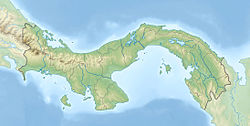Gatún Formation
| Gatún Formation | |
|---|---|
| Stratigraphic range: Latest Serravallian-Tortonian (Clarendonian-Hemphillian) ~ | |
| Type | Formation |
| Underlies | alluvium |
| Overlies | Caimito Formation, unnamed Cretaceous volcanics |
| Lithology | |
| Primary | Sandstone, siltstone |
| Other | Tuff, conglomerate |
| Location | |
| Coordinates | 9°18′N 79°48′W / 9.3°N 79.8°W |
| Approximate paleocoordinates | 8°54′N 78°06′W / 8.9°N 78.1°W |
| Region | Colón Province |
| Country | |
| Extent | Panama Basin |
| Type section | |
| Named for | Lake Gatún |
| Named by | Howe |
| Year defined | 1907 |
The Gatún Formation (Tg)[1] is a geologic formation in the Colón and Panamá Provinces of central Panama. The formation crops out in and around the Panama Canal Zone. The coastal to marginally marine sandstone, siltstone, claystone, tuff and conglomerate formation dates to the latest Serravallian to Tortonian (Clarendonian to Hemphillian in the NALMA classification), from 12 to 8.5 Ma.[2][3] It preserves many fossils, among others, megalodon teeth have been found in the formation.
Description[edit]
The Gatún Formation was first defined and named as such by Howe in 1907. The formation was known before and when William Phipps Blake traveled across Panama in 1853 on his way to California to join one of the transcontinental railroad surveying parties, he collected a few Gatún Formation fossils.[4] In the Canal Zone the contact between the formation with the underlying Caimito Formation is covered by the waters of Lake Gatún and even before the flooding of the lake perhaps all of the contact was concealed by swamps.[5]
Massive medium- to very fine-grained sandstones and siltstones are the chief constituents of the Gatún Formation. They are somewhat calcareous, or marly, somewhat tuffaceous, and have a clay-like matrix. The sandstone contains numerous grains of black and greenish volcanic rocks and is practically a subgraywacke. Conglomerates and hard brittle very fine-grained tuff make up a small part of the formation. Basalt intrudes older formations in the Lake Gatún area, but is not known to penetrate the Gatún Formation.[5]
Fossil content[edit]
- Agatrix agathe[6]
- Aphera aphrodite[6]
- Axelella cativa[6]
- Bivetiella dilatata[6]
- Cancellaria harzhauseri, C. mixta[6]
- Otodus megalodon
- Carinodrillia zooki
- Chilomycterus exspectatus, C. tyleri[7]
- Conasprella burckhardti, C. imitator
- Conus (Stephanoconus) woodringi[8]
- Cryoturris habra
- Cynoscion latiostialis, C. scitulus[9]
- Diaphus apalus, D. gatunensis[10]
- Euclia alacertata[6]
- Hindsiclava consors
- Lepophidium gentilis[11]
- Leucosyrinx xenica
- Massyla toulai[6]
- Pyruclia tweedledee, P. tweedledum[6]
- Umbrina opima[9]
- Ventrilia coatesi[6]
See also[edit]
References[edit]
- ^ Geologic Map, 1980
- ^ Aguilera et al., 2017, p.5
- ^ Gatún Formation at Fossilworks.org
- ^ Woodring, 1957, p.42
- ^ a b Woodring, 1957, p.43
- ^ a b c d e f g h i Landau et al., 2012
- ^ Aguilera et al., 2017
- ^ Hendricks, 2018
- ^ a b Aguilera et al., 2016
- ^ Schwarzhans & Aguilera, 2013
- ^ Schwarzhans & Aguilera, 2016
Bibliography[edit]
- Aguilera, Órangel; Guilherme Oliveira Andrade Silva; Ricardo Tadeu Lopes; Alessandra Silveira Machado; Thaís Maria Dos Santos; Gabriela Marques; Thayse Bertucci; Thayanne Aguiar, and Jorge Carrillo Briceño and Felix Rodríguez, Carlos Jaramillo. 2017. Neogene Proto-Caribbean porcupinefishes (Diodontidae). PLoS ONE 12(7). 1–26. Accessed 2019-02-09.
- Aguilera, Órangel A.; Werner Schwarzhans, and Philippe Béarez. 2016. Otoliths of the Sciaenidae from the Neogene of tropical America. Palaeo Ichthyologica 14. 7–90. Accessed 2019-02-09.
- Beu, A.G. 2010. Neogene Tonnoidean Gastropods of Tropical and South America; contributions to the Dominican Republic and Panama Paleontology Projects and Uplift of the Central American Isthmus. Bulletins of American Paleontology 377-378. 1–550. Accessed 2019-02-09.
- Cadena, E.; J.R. Bourque; A.F. Rincón; J.I. Bloch; C.A. Jaramillo, and B.J. MacFadden. 2012. New turtles (Chelonia) from the late Eocene through Late Miocene of the Panama Canal Basin. Journal of Paleontology 86. 539–557. Accessed 2019-02-09.
- Hendricks, Jonathan R. 2018. Diversity and preserved shell coloration patterns of Miocene Conidae (Neogastropoda) from an exposure of the Gatun Formation, Colón Province, Panama. Journal of Paleontology 92(5). 804–837. Accessed 2019-02-09.
- Landau, Bernard; Richard E. Petit, and Carlos M. Da Silva. 2012. New Cancellariidae (Mollusca, Gastropoda) from the Miocene Gatun Formation of Panama, with Eleven New Species. Journal of Paleontology 86(6). 907–930. Accessed 2019-02-09.
- Schwarzhans, Werner, and Órangel Aguilera. 2016. Otoliths of the Ophidiiformes from the Neogene of tropical America. Palaeo Ichthyologica 14. 91–124. Accessed 2019-02-09.
- Schwarzhans, Werner, and Órangel Aguilera. 2013. Otoliths of the Myctophidae from the Neogene of tropical America. Palaeo Ichthyologica 13. 83–150. Accessed 2019-02-09.
- Woodring, W.P. 1957. Geology and Paleontology of Canal Zone and Adjoining Parts of Panama - 306A Geology and description of Tertiary mollusks (Gastropods: Trochidae to Turritellidae), 1–186. USGS. Accessed 2019-02-09.
- Stewart, R.H.; J.L. Stewart, and W.P. Woodring. 1980. Geologic Map of the Panama Canal and Vicinity, 1. USGS. Accessed 2019-02-09.
Further reading[edit]
- C. Pimiento, G. González-Barba, D. J. Ehret, B. J. MacFadden, A. J. W. Hendy and C. Jaramillo. 2013. Sharks and Rays (Chondrichthyes, Elasmobranchii) from the late Miocene Gatún Formation of Panama. Journal of Paleontology 87(5):755-774

